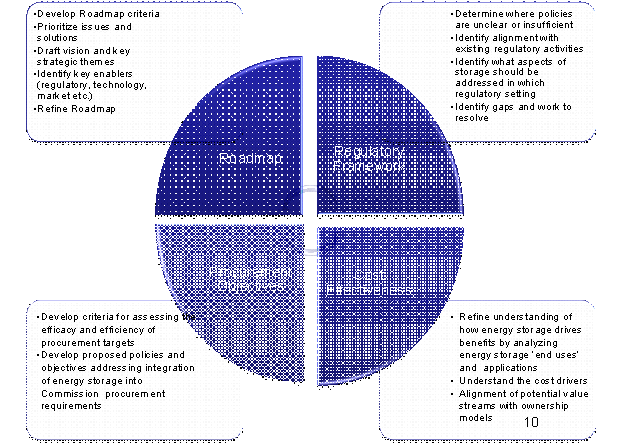5. Staff Proposal
As directed by the Scoping Memo, Staff reviewed parties' comments and submitted its Initial Proposal on December 2, 2011. Based on input from parties,69 Staff submitted the Final Proposal on April 3, 2012.70 The Final Proposal includes a Storage Barriers Regulatory Matrix, with summarizes the various barriers and policies faced by energy storage developers.71 Based on this matrix, Staff proposed a framework to analyze energy storage.
This proposed framework identifies 20 "end uses" for energy storage and where in the value chain storage is being used. The identified Energy Storage "End Uses" is presented in Table 1 below:
TABLE 1
Energy Storage "End Uses"
Category |
Storage `End Use' | |
Describes at what point in the value chain storage is being used |
Describes what storage is being used for, i.e. its application. | |
ISO/Market |
1 |
Ancillary services: frequency regulation |
2 |
Ancillary services: spin/ non-spin/ replacement reserves | |
3 |
Ancillary services: ramp | |
4 |
Black start | |
5 |
Real time energy balancing | |
6 |
Energy price arbitrage | |
7 |
Resource Adequacy | |
Generation |
8 |
Intermittent resource integration: wind (ramp/voltage support) |
9 |
Intermittent resource integration: photovoltaic (time shift, voltage sag, rapid demand support) | |
10 |
Supply firming | |
Transmission/ Distribution |
11 |
Peak shaving |
12 |
Transmission peak capacity support (upgrade deferral) | |
13 |
Transmission operation (short duration performance, inertia, system reliability) | |
14 |
Transmission congestion relief | |
15 |
Distribution peak capacity support (upgrade deferral) | |
16 |
Distribution operation (voltage / VAR support) | |
Customer |
17 |
Outage mitigation: micro-grid |
18 |
Time-of-use (TOU) energy cost management | |
19 |
Power quality | |
20 |
Back-up power |
The Final Proposal states that decomposing energy storage into various end uses will allow for more manageable analysis. Staff further stresses that analyzing each individual end use is not intended to eliminate analysis of energy storage comprehensively. "[By] focusing on the specific `end uses' it will become apparent which aspects of energy storage are unique to specific applications and which aspects of storage are common across all uses."72
The analysis approach would consist of four major categories - regulatory framework, cost effectiveness, procurement objectives and energy storage roadmap - as pictured in Table 2 below:
Table 2
Energy Storage Analysis Approach

Staff states that its proposed analysis process will assist in framing energy storage policy. Notably, Staff states that the outcomes of the analysis "will be used to evaluate whether or not to adopt a procurement target or if other policy options are better suited to meet the objectives of AB 2514."73
Staff requests that the Final Proposal be adopted. Staff further recommends that as part of Phase 2 of this proceeding, the end uses identified in Table 1 above be prioritized and that those considered higher priority be analyzed first. To that end, the Final Proposal includes four basic "scenarios" for defining ESS, including different combinations of end uses. These scenarios are intended to align with existing state and Commission policy objectives particularly those related to increasing renewables and distributed generation, reducing greenhouse gas emissions, limiting peak growth and modernizing the grid. The four scenarios proposed by further analysis are:
1. Renewables Support/Dispatchability - Focus on how energy storage can be used to support renewable generation, both at the transmission level and at the distribution level to improve the dispatchability and value of the renewable resource.
2. Distributed Storage - Focus on distribution-level storage, particularly to support grid operation, and whether storage can be utilized as a distribution-level generation resource.
3. Demand-Side Management - Focus on energy storage at the customer level (behind-the-meter storage).74
4. Ancillary Services - Focus on energy storage systems at the transmission level to provide generator-like services for ancillary markets.75
69 Comments on the initial proposal were filed by Brookfield, CESA, CAISO, Calpine, CFC, DRA, Jack Ellis, MegaWatt Storage Farms, PG&E, SDG&E, Sierra Club, SCE, and VoteSolar. Reply comments were filed by CESA, CFC, DRA, Mark B. Lively, Longview Energy Exchange, NGK Insulators (NGK), PG&E, SCE, SDG&E, Sierra Club, and VoteSolar.
70 The Final Proposal is Attachment A of this decision.
71 Staff notes that this matrix is not static, but rather will be refined and updated to reflect additional information and new developments. Therefore, it is anticipated that the Storage Barriers Regulatory Matrix will be continuously revised to consider new proceedings impacting the various barriers, such as the new LTPP proceeding A.12-05-014.
72 Final Proposal at 15.
73 Final Proposal at 17.
74 Some aspects of this scenario are already being evaluated in other Commission proceedings.
75 The Final Proposal notes that although this is primarily within the CAISO's jurisdiction, the Commission could collaborate with the CAISO to explore how distribution-level storage can participate in ancillary services through a utility tariff.



